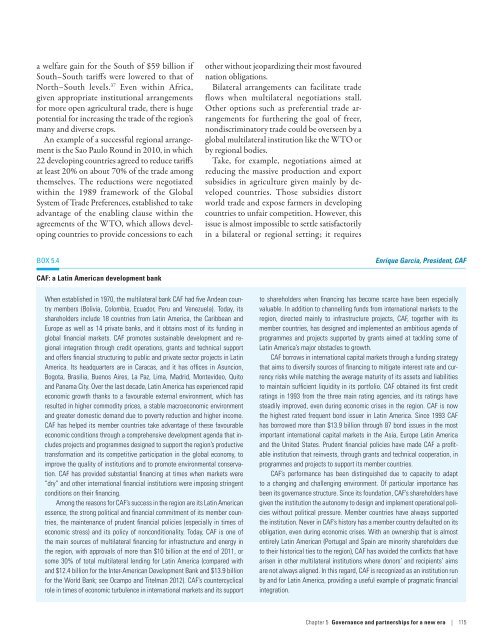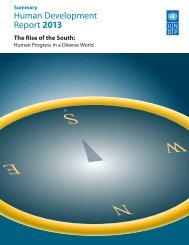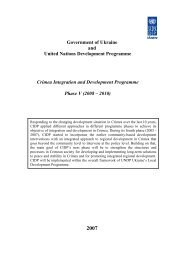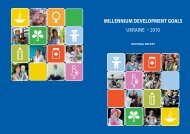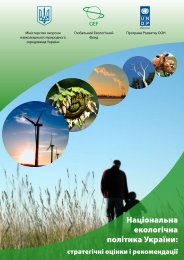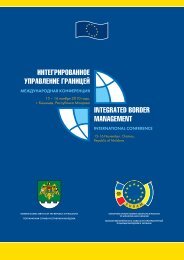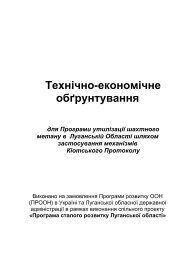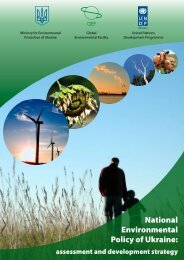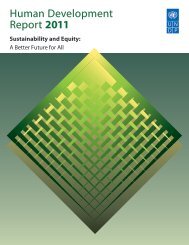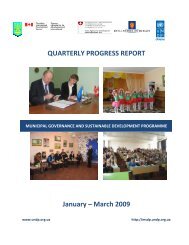E N S W - United Nations Development Programme
E N S W - United Nations Development Programme
E N S W - United Nations Development Programme
You also want an ePaper? Increase the reach of your titles
YUMPU automatically turns print PDFs into web optimized ePapers that Google loves.
a welfare gain for the South of $59 billion if<br />
South–South tariffs were lowered to that of<br />
North–South levels. 37 Even within Africa,<br />
given appropriate institutional arrangements<br />
for more open agricultural trade, there is huge<br />
potential for increasing the trade of the region’s<br />
many and diverse crops.<br />
An example of a successful regional arrangement<br />
is the Sao Paulo Round in 2010, in which<br />
22 developing countries agreed to reduce tariffs<br />
at least 20% on about 70% of the trade among<br />
themselves. The reductions were negotiated<br />
within the 1989 framework of the Global<br />
System of Trade Preferences, established to take<br />
advantage of the enabling clause within the<br />
agreements of the WTO, which allows developing<br />
countries to provide concessions to each<br />
other without jeopardizing their most favoured<br />
nation obligations.<br />
Bilateral arrangements can facilitate trade<br />
flows when multilateral negotiations stall.<br />
Other options such as preferential trade arrangements<br />
for furthering the goal of freer,<br />
nondiscriminatory trade could be overseen by a<br />
global multilateral institution like the WTO or<br />
by regional bodies.<br />
Take, for example, negotiations aimed at<br />
reducing the massive production and export<br />
subsidies in agriculture given mainly by developed<br />
countries. Those subsidies distort<br />
world trade and expose farmers in developing<br />
countries to unfair competition. However, this<br />
issue is almost impossible to settle satisfactorily<br />
in a bilateral or regional setting; it requires<br />
Box 5.4<br />
Enrique Garcia, President, CAF<br />
CAF: a Latin American development bank<br />
When established in 1970, the multilateral bank CAF had five Andean country<br />
members (Bolivia, Colombia, Ecuador, Peru and Venezuela). Today, its<br />
shareholders include 18 countries from Latin America, the Caribbean and<br />
Europe as well as 14 private banks, and it obtains most of its funding in<br />
global financial markets. CAF promotes sustainable development and regional<br />
integration through credit operations, grants and technical support<br />
and offers financial structuring to public and private sector projects in Latin<br />
America. Its headquarters are in Caracas, and it has offices in Asuncion,<br />
Bogota, Brasilia, Buenos Aires, La Paz, Lima, Madrid, Montevideo, Quito<br />
and Panama City. Over the last decade, Latin America has experienced rapid<br />
economic growth thanks to a favourable external environment, which has<br />
resulted in higher commodity prices, a stable macroeconomic environment<br />
and greater domestic demand due to poverty reduction and higher income.<br />
CAF has helped its member countries take advantage of these favourable<br />
economic conditions through a comprehensive development agenda that includes<br />
projects and programmes designed to support the region’s productive<br />
transformation and its competitive participation in the global economy, to<br />
improve the quality of institutions and to promote environmental conservation.<br />
CAF has provided substantial financing at times when markets were<br />
“dry” and other international financial institutions were imposing stringent<br />
conditions on their financing.<br />
Among the reasons for CAF’s success in the region are its Latin American<br />
essence, the strong political and financial commitment of its member countries,<br />
the maintenance of prudent financial policies (especially in times of<br />
economic stress) and its policy of nonconditionality. Today, CAF is one of<br />
the main sources of multilateral financing for infrastructure and energy in<br />
the region, with approvals of more than $10 billion at the end of 2011, or<br />
some 30% of total multilateral lending for Latin America (compared with<br />
and $12.4 billion for the Inter-American <strong>Development</strong> Bank and $13.9 billion<br />
for the World Bank; see Ocampo and Titelman 2012). CAF’s countercyclical<br />
role in times of economic turbulence in international markets and its support<br />
to shareholders when financing has become scarce have been especially<br />
valuable. In addition to channelling funds from international markets to the<br />
region, directed mainly to infrastructure projects, CAF, together with its<br />
member countries, has designed and implemented an ambitious agenda of<br />
programmes and projects supported by grants aimed at tackling some of<br />
Latin America’s major obstacles to growth.<br />
CAF borrows in international capital markets through a funding strategy<br />
that aims to diversify sources of financing to mitigate interest rate and currency<br />
risks while matching the average maturity of its assets and liabilities<br />
to maintain sufficient liquidity in its portfolio. CAF obtained its first credit<br />
ratings in 1993 from the three main rating agencies, and its ratings have<br />
steadily improved, even during economic crises in the region. CAF is now<br />
the highest rated frequent bond issuer in Latin America. Since 1993 CAF<br />
has borrowed more than $13.9 billion through 87 bond issues in the most<br />
important international capital markets in the Asia, Europe Latin America<br />
and the <strong>United</strong> States. Prudent financial policies have made CAF a profitable<br />
institution that reinvests, through grants and technical cooperation, in<br />
programmes and projects to support its member countries.<br />
CAF’s performance has been distinguished due to capacity to adapt<br />
to a changing and challenging environment. Of particular importance has<br />
been its governance structure. Since its foundation, CAF’s shareholders have<br />
given the institution the autonomy to design and implement operational policies<br />
without political pressure. Member countries have always supported<br />
the institution. Never in CAF’s history has a member country defaulted on its<br />
obligation, even during economic crises. With an ownership that is almost<br />
entirely Latin American (Portugal and Spain are minority shareholders due<br />
to their historical ties to the region), CAF has avoided the conflicts that have<br />
arisen in other multilateral institutions where donors’ and recipients’ aims<br />
are not always aligned. In this regard, CAF is recognized as an institution run<br />
by and for Latin America, providing a useful example of pragmatic financial<br />
integration.<br />
Chapter 5 Governance and partnerships for a new era | 115


